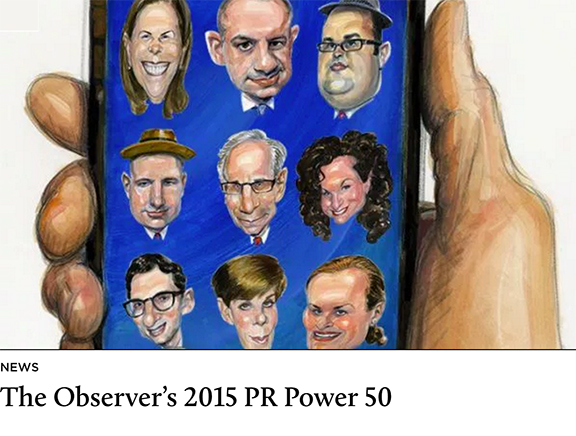 There may still be agencies, somewhere, practicing public relations the old fashioned way, where press releases, pitching and parties define the scope of work.
There may still be agencies, somewhere, practicing public relations the old fashioned way, where press releases, pitching and parties define the scope of work.
But the firms that populate this year’s PR Power 50 are part of a thrilling revolution that’s transforming public relations into the most powerful engine in the great media-communications complex.
Firms are creating client stories, not just telling them. They’re not just guarding reputations, but active partners in nurturing them.
Jennifer Prosek's steamroller of a firm reps more than $4 trillion in Wall Street money, and its blue-chip New York clients include Bloomberg, Nasdaq and Goldman Sachs. But the fact that the Prosek team also represents Bridgewater Associates (the largest hedge fund in the world) and Man Group (the largest publicly traded fund in the world) proves it’s a continuing worldwide power in the sector.
Perhaps most significantly, they’re breaking down boundaries to become key partners across the marketing spectrum, muscling in on territory once dominated by ad agencies, digital firms and content producers.
At a time when content reigns, “Public relations agencies are now regarded as stewards of the whole communications strategy,” says Andy Polansky, CEO of Weber Shandwick (No. 2 on this year’s PR Power 50 list). “PR practitioners have never been held in higher regard.”
Ever-expanding opportunities across the marketing spectrum make this “the most exciting time there’s ever been for the business,” says Don Baer, worldwide chair and CEO of Burson-Marsteller (No. 17). “Everyone is veering into everyone else’s lane. And if you have the creativity, and the ability to execute, it’s a time of great possibilities.”
What matters most is who owns a great idea, agrees Sean Cassidy, CEO of DKC, the No. 1 agency on this year’s PR Power 50 list.
“Clients will pay you now for a whole scope of services that you never would have done 20 years ago,” Mr. Cassidy says. “What we’re winning now is large-scale assignments. You’re developing multi-platform communications plans with wide content, owned media, social pieces. We’ve got a branding arm that’s creating collateral and advertising, and we’re doing more events than ever.”
More firms are also building their own synergies with standalone agencies within agencies. At celebrity power shop PMK*BNC, a mini-firm called Vowel is creating viral content through which the agency’s superstar celebrity clients often get paired with big brands in the PMK stable. A now-legendary piece for Audi starring Zachary Quinto and the late Leonard Nimoy was unleashed before the last Star Trek movie.
“It was wonderful, creative digital content that was storyboarded start to finish under our roof,” says Cindi Berger, chairman and CEO of PMK*BNC (No. 8). “There’s a lot of freedom out there for you and your clients. You just have to know what trail you want to go on.” PMK markets Lena Dunham’s “Lenny Letter”, which has become a huge viral hit in an area where a traditional firm wouldn’t have ventured even five years ago.
An unintended consequence of this push and pull—convergence and diffusion—has been the resurgence of legacy agencies, which many had dismissed as dinosaurs once the landscape started shifting a few years ago.
Instead, they learned to adapt, meshing cool new tools and lingo with their own gravitas as the grownups in the room.
“We bring the judgment and experience that goes along with strategic thinking,” says Mr. Baer of Burson, which launched a content arm called StudioB this year. “And we’re seasoning it with data, creativity and deep knowledge of media landscape. We’re moving forward very assertively.”
Sixty-seven-year-old Ruder Finn (No. 10), not long ago one of the stodgiest of the big players, has reinvented itself as a hip think tank, where clients get help with employee engagement, recruitment and even how their businesses are organized. “We call it ideation behind transformation,” says CEO Kathy Bloomgarden, one of the few agency heads with a Ph.D. “We work to transform companies to make them more attractive to stakeholders both inside and outside. We sometimes help them change their culture.”
All of it comes back to storytelling, says Weber Shandwick’s Mr. Polansky, which is why PR firms should continue to rule.
“Creative is still king,” he says. “Clients are looking for big ideas that are going to move the needle for their businesses, have an impact on how people think about their brands and influence decisions.”
This year’s list reflects that.
A word on methodology: Unlike other rankings, the Observer doesn’t rely solely on size or revenue. We visit offices, meet agency leaders, confer with fellow journalists and keep an eye on news. The PR Power 50 list is as much about mojo, influence, innovation and chutzpah—but not too much, as last year’s No. 1 winner learned—as it is about billables.
Isn’t that what the business is about, too?
